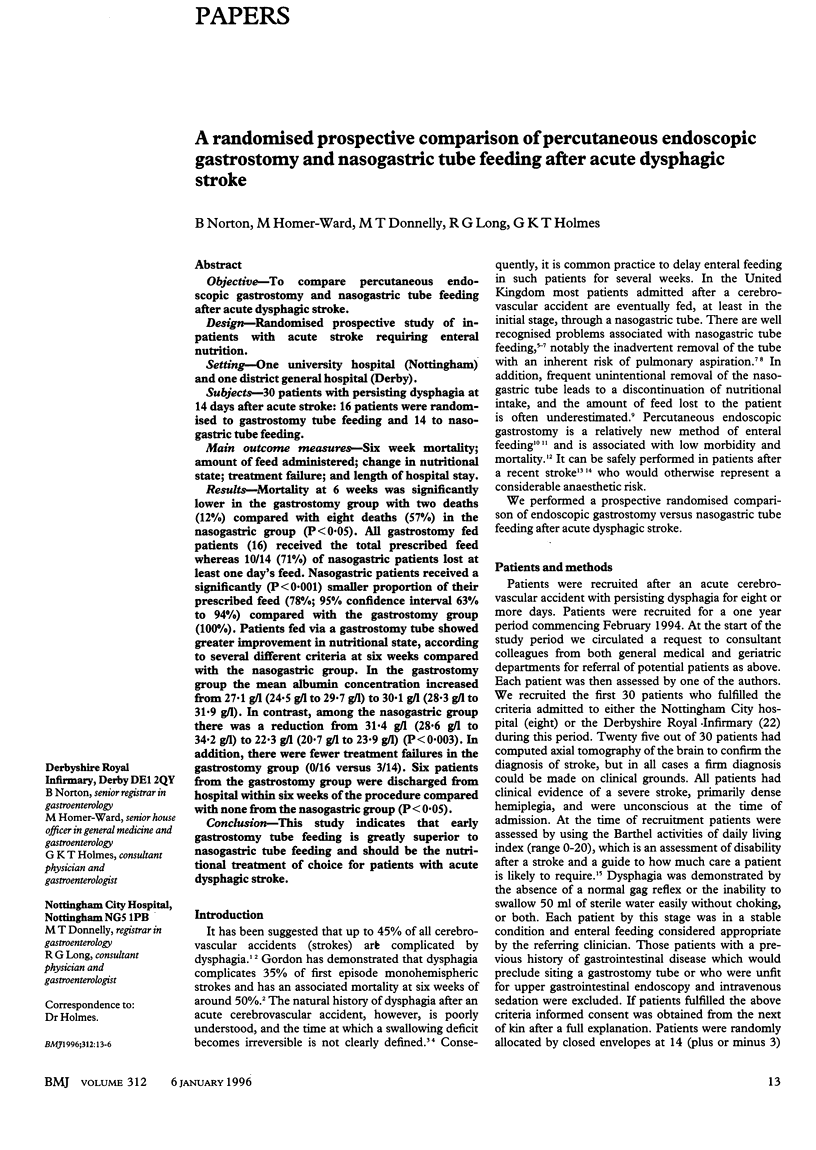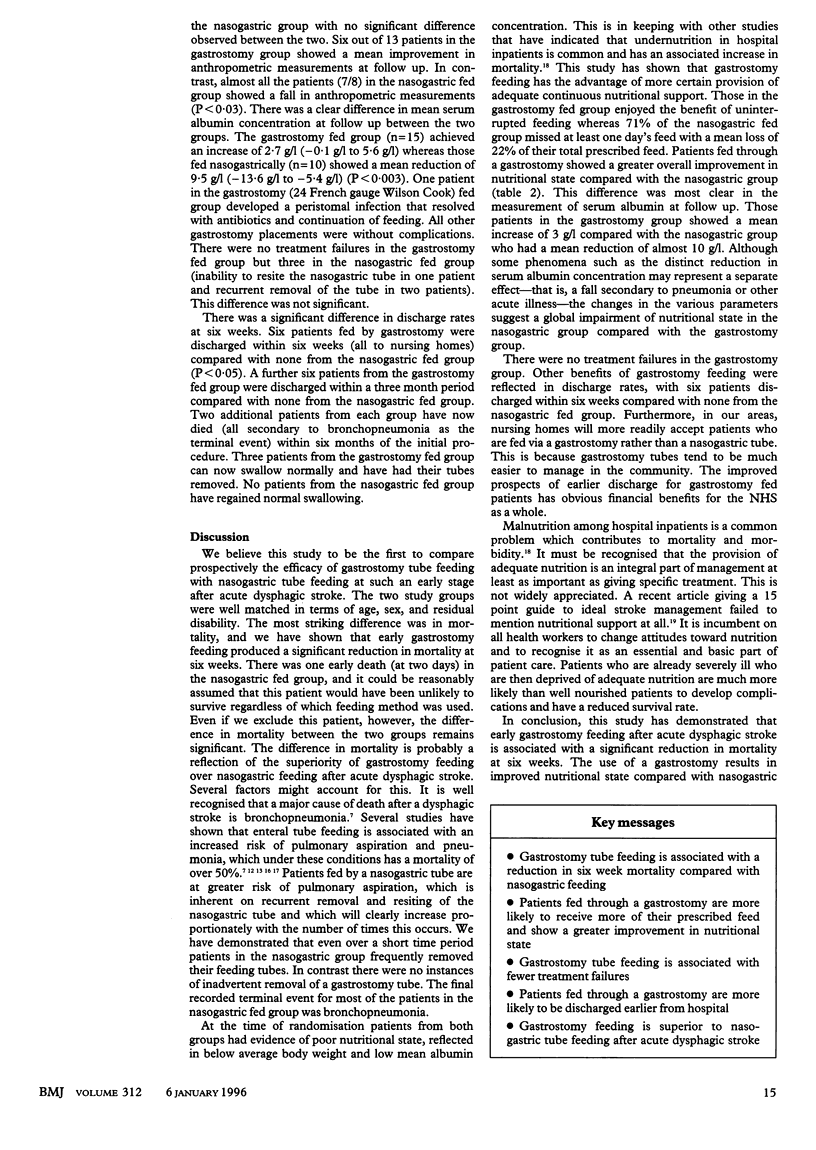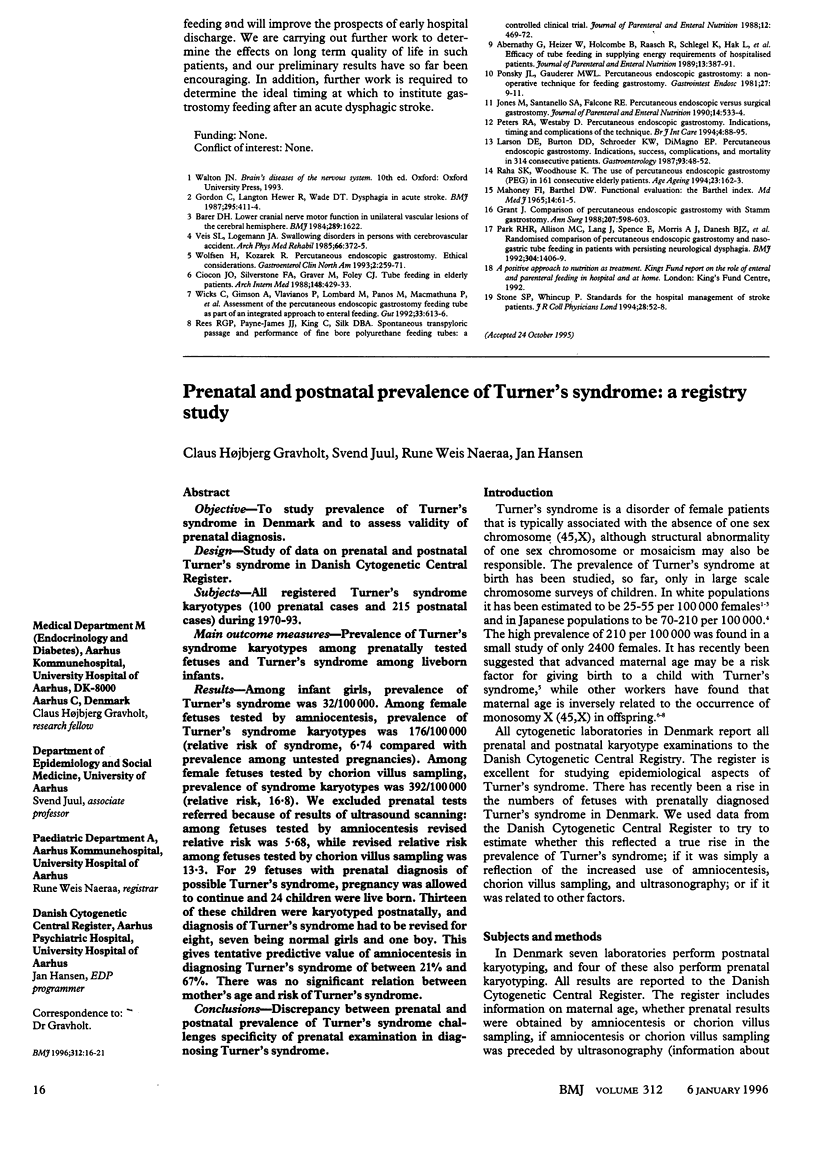Abstract
OBJECTIVE--To compare percutaneous endoscopic gastrostomy and nasogastric tube feeding after acute dysphagic stroke. DESIGN--Randomised prospective study of inpatients with acute stroke requiring enteral nutrition. SETTING--One university hospital (Nottingham) and one district general hospital (Derby). SUBJECTS--30 patients with persisting dysphagia at 14 days after acute stroke: 16 patients were randomised to gastrostomy tube feeding and 14 to nasogastric tube feeding. MAIN OUTCOME MEASURES--Six week mortality; amount of feed administered; change in nutritional state; treatment failure; and length of hospital stay. RESULTS--Mortality at 6 weeks was significantly lower in the gastrostomy group with two deaths (12%) compared with eight deaths (57%) in the nasogastric group (P < 0.05). All gastrostomy fed patients (16) received the total prescribed feed whereas 10/14 (71%) of nasogastric patients lost at least one day's feed. Nasogastric patients received a significantly (P < 0.001) smaller proportion of their prescribed feed (78%; 95% confidence interval 63% to 94%) compared with the gastrostomy group (100%). Patients fed via a gastrostomy tube showed greater improvement in nutritional state, according to several different criteria at six weeks compared with the nasogastric group. In the gastrostomy group the mean albumin concentration increased from 27.1 g/l (24.5 g/l to 29.7 g/l) to 30.1 g/l (28.3 g/l to 31.9 g/l). In contrast, among the nasogastric group there was a reduction from 31.4 g/l (28.6 g/l to 34.2 g/l) to 22.3 g/l (20.7 g/l to 23.9 g/l) (P < 0.003). In addition, there were fewer treatment failures in the gastrostomy group (0/16 versus 3/14). Six patients from the gastrostomy group were discharged from hospital within six weeks of the procedure compared with none from the nasogastric group (P < 0.05). CONCLUSION--This study indicates that early gastrostomy tube feeding is greatly superior to nasogastric tube feeding and should be the nutritional treatment of choice for patients with acute dysphagic stroke.
Full text
PDF



Selected References
These references are in PubMed. This may not be the complete list of references from this article.
- Abernathy G. B., Heizer W. D., Holcombe B. J., Raasch R. H., Schlegel K. E., Hak L. J. Efficacy of tube feeding in supplying energy requirements of hospitalized patients. JPEN J Parenter Enteral Nutr. 1989 Jul-Aug;13(4):387–391. doi: 10.1177/0148607189013004387. [DOI] [PubMed] [Google Scholar]
- Ciocon J. O., Silverstone F. A., Graver L. M., Foley C. J. Tube feedings in elderly patients. Indications, benefits, and complications. Arch Intern Med. 1988 Feb;148(2):429–433. [PubMed] [Google Scholar]
- Grant J. P. Comparison of percutaneous endoscopic gastrostomy with Stamm gastrostomy. Ann Surg. 1988 May;207(5):598–603. doi: 10.1097/00000658-198805000-00014. [DOI] [PMC free article] [PubMed] [Google Scholar]
- Howie J. Portraits from memory. 16--Muriel Robertson, FRS (1883-1973). Br Med J (Clin Res Ed) 1987 Jul 4;295(6589):41–41. doi: 10.1136/bmj.295.6589.41. [DOI] [PMC free article] [PubMed] [Google Scholar]
- Jones M., Santanello S. A., Falcone R. E. Percutaneous endoscopic vs surgical gastrostomy. JPEN J Parenter Enteral Nutr. 1990 Sep-Oct;14(5):533–534. doi: 10.1177/0148607190014005533. [DOI] [PubMed] [Google Scholar]
- Larson D. E., Burton D. D., Schroeder K. W., DiMagno E. P. Percutaneous endoscopic gastrostomy. Indications, success, complications, and mortality in 314 consecutive patients. Gastroenterology. 1987 Jul;93(1):48–52. [PubMed] [Google Scholar]
- MAHONEY F. I., BARTHEL D. W. FUNCTIONAL EVALUATION: THE BARTHEL INDEX. Md State Med J. 1965 Feb;14:61–65. [PubMed] [Google Scholar]
- Park R. H., Allison M. C., Lang J., Spence E., Morris A. J., Danesh B. J., Russell R. I., Mills P. R. Randomised comparison of percutaneous endoscopic gastrostomy and nasogastric tube feeding in patients with persisting neurological dysphagia. BMJ. 1992 May 30;304(6839):1406–1409. doi: 10.1136/bmj.304.6839.1406. [DOI] [PMC free article] [PubMed] [Google Scholar]
- Ponsky J. L., Gauderer M. W. Percutaneous endoscopic gastrostomy: a nonoperative technique for feeding gastrostomy. Gastrointest Endosc. 1981 Feb;27(1):9–11. doi: 10.1016/s0016-5107(81)73133-x. [DOI] [PubMed] [Google Scholar]
- Raha S. K., Woodhouse K. The use of percutaneous endoscopic gastrostomy (PEG) in 161 consecutive elderly patients. Age Ageing. 1994 Mar;23(2):162–163. doi: 10.1093/ageing/23.2.162. [DOI] [PubMed] [Google Scholar]
- Rees R. G., Payne-James J. J., King C., Silk D. B. Spontaneous transpyloric passage and performance of 'fine bore' polyurethane feeding tubes: a controlled clinical trial. JPEN J Parenter Enteral Nutr. 1988 Sep-Oct;12(5):469–472. doi: 10.1177/0148607188012005469. [DOI] [PubMed] [Google Scholar]
- Stone S. P., Whincup P. Standards for the hospital management of stroke patients. J R Coll Physicians Lond. 1994 Jan-Feb;28(1):52–58. [PMC free article] [PubMed] [Google Scholar]
- Veis S. L., Logemann J. A. Swallowing disorders in persons with cerebrovascular accident. Arch Phys Med Rehabil. 1985 Jun;66(6):372–375. [PubMed] [Google Scholar]
- Wicks C., Gimson A., Vlavianos P., Lombard M., Panos M., Macmathuna P., Tudor M., Andrews K., Westaby D. Assessment of the percutaneous endoscopic gastrostomy feeding tube as part of an integrated approach to enteral feeding. Gut. 1992 May;33(5):613–616. doi: 10.1136/gut.33.5.613. [DOI] [PMC free article] [PubMed] [Google Scholar]


